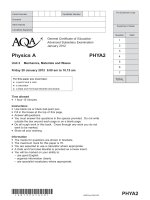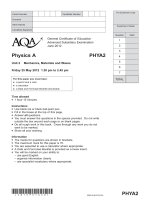AQA ANTH1 QP JAN13
Bạn đang xem bản rút gọn của tài liệu. Xem và tải ngay bản đầy đủ của tài liệu tại đây (109.78 KB, 4 trang )
General Certificate of Education
Advanced Subsidiary Examination
January 2013
Anthropology
Unit 1
ANTH1
Being Human: Unity and Diversity
Wednesday 9 January 2013
9.00 am to 10.30 am
For this paper you must have:
l an AQA 12-page answer book.
Time allowed
l 1 hour 30 minutes
Instructions
l Use black ink or black ball-point pen.
l Write the information required on the front of your answer book. The Examining Body for this
paper is AQA. The Paper Reference is ANTH1.
l Answer all questions.
l Do all rough work in your answer book. Cross through any work you do not want to be marked.
Information
l The marks for questions are shown in brackets.
l The maximum mark for this paper is 70.
l Questions carrying 10 marks or more should be answered in continuous prose. In these questions
you will be marked on your ability to:
– use good English
– organise information clearly
– use specialist vocabulary where appropriate.
H/Jan13/ANTH1
ANTH1
2
Answer all questions.
Total: 70 marks
Read Items A and B below and answer all the questions that follow.
Item A
All social mammals seek power and therefore create hierarchies. Male chimpanzees strive
to become the ‘alpha’ male in the troop so that they can mate with more females. However,
chimps do not rely on brute strength alone. They use cunning and, above all, they form
alliances. These alliances may be based on family ties. Similarly, men gain power by
gathering allies around them. Among human beings, wealth is a way of putting together
alliances of power. The rewards for chimps are largely sexual, but what are the rewards for
men?
Source: adapted from The Red Queen, Matt Ridley, 1993, Penguin.
Item B
According to Anne Becker’s study Body, Self and Society (1995), people in the West and
people in Fiji have very different attitudes towards the female body.
In the West, the ideal body shape is thin, and individuals go on diets and ‘keep fit’ programmes
in order to achieve this ideal.
Fijians prefer a much larger body shape. This is because the individual’s body has a special
relationship with the community; a ‘robust’ body is a sign that the individual is well cared for.
People will still make positive or negative comments about bodies, but the individual does not
feel obliged to try to change her own body. It is the responsibility of the community to care for
the body of each individual.
However, young women who leave their villages to be educated in the city are now becoming
more westernised in their attitudes. Owing to the influence of the media, they now want to
achieve a much slimmer body.
H/Jan13/ANTH1
3
0
1
0
2
0
3
0
4
0
5
0
6
Explain what is meant by ‘hierarchy’ and illustrate your explanation with an example,
(4 marks)
apart from ‘alpha’ males among chimpanzees (Item A).
Identify and briefly explain two reasons why some people believe in witchcraft.
(6 marks)
Examine two or more ways in which humans use the natural environment, such as
(10 marks)
animals and plants, as part of their classification systems.
Analyse two or more ways in which humans and apes are similar in their social
(10 marks)
relations, apart from hierarchies and alliances (Item A).
Examine the role of gift exchange and reciprocity in human society.
Using material from Item B and elsewhere, assess the extent to which the body is a
(20 marks)
cultural creation rather than a biological creation.
END OF QUESTIONS
H/Jan13/ANTH1
(20 marks)
4
There are no questions printed on this page
ACKNOWLEDGEMENT OF COPYRIGHT-HOLDERS AND PUBLISHERS
Permission to reproduce all copyright material has been applied for. In some cases, efforts to contact copyright-holders have been unsuccessful and AQA will
be happy to rectify any omissions of acknowledgements in future papers if notified.
Copyright © 2013 AQA and its licensors. All rights reserved.
H/Jan13/ANTH1









